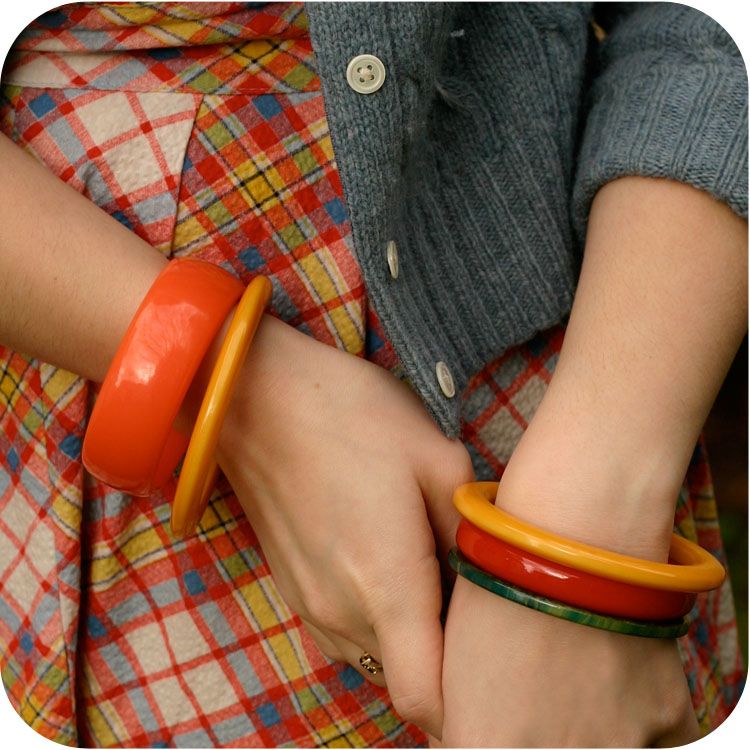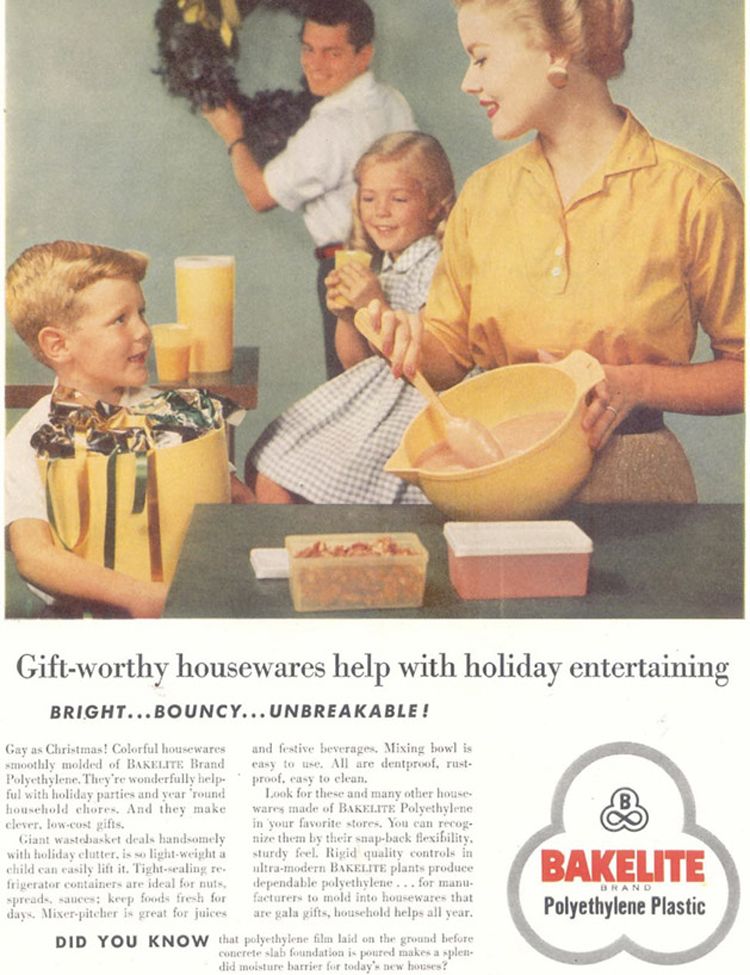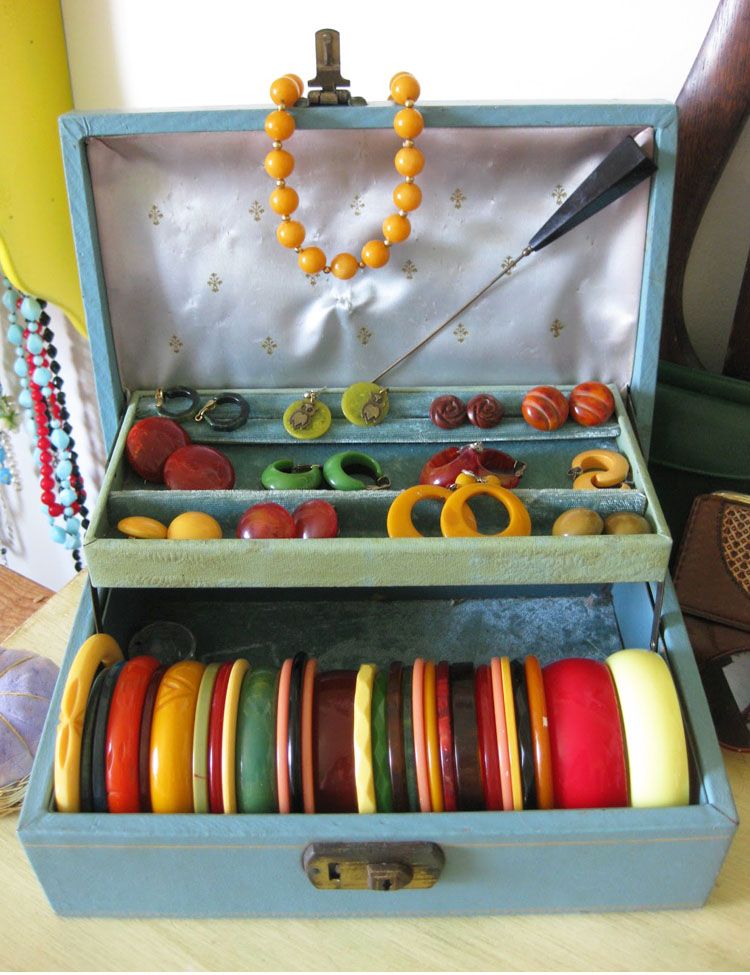

Kaufmann Mercantile
Bakelite was first utilized as pool balls, kitchen utensil handles, radios, camera cases and many more ridiculous things. I once saw a Bakelite hanger. And baby mobile. In 1927 the patent for Bakelite expired and was purchased by The Catalin Corporation. This is when the real fun began (at least for fashion reasons). Catalin is every so slightly different than Bakelite as it is made from either phenol, melamine, or urea formaldehyde. This means there's usually no fillers, and is a little less durable than the original Bakelite formula. Though most of the jewelry we find today referred to as Bakelite is actually Catalin. There are other makers of the plastic, but all the information I find is conflicting, so if you're interested you can research the subject on your own.
In the 1930s the depression hit in the U.S. and Bakelite had perfect timing. It was easy to make, cheap, and colorful. Not only made in bangle form, but also carved necklaces, brooches, shoe clips, every novelty design to lift the spirits and freshen up a frock. In the 1940s we entered the war, and metal was scarce. Bakelite saves the day again! It had quite a good run. It's popularity dwindled through the 50s and 60s, and is now desired by jewelry collectors and vintage wearers.

It used to be very easy to find at estate sales and thrift stores. Since it's plastic I'd find bangles tossed in a box of costume jewelry for 50 cents a piece. Now it's near impossible, and even if you do find it, it's value is well known, and it's price marked up.
"But Solanah, how on earth can you tell the difference between Bakelite and normal plastic?"
Well my dears (ew, I promise I'll never say that again), it's all about the smell. You remember what it's made of right?
That's alright. I'll wait while you go back and read it....
...Yes, ok then.
So if you rub the surface of a Bakelite item with your thumb until it feels hot, it should smell like formaldehyde.
I have just turned you into that crazy person at thrift stores smelling jewelry. You're welcome.
If you missed cadaver day in science class and don't know what formaldehyde smells like, just sniff for a chemical scent.
There are other tests as well, but I've never had to use any other method, so I'm not about to tell you to buy a bunch of extra stuff if I've never tried them.
So there you go. Bakelite. Or Catalin. Or Phenol Formaldehyde resin. Whatever you call it, I love it. Next up, how to "polish" it.
Information sources
........Bakelite and Catalin.....
........History of Bakelite.......

23 comments:
That was totally fascinating. I am definitely employing that smell method of finding Bakelite now.
Thanks for sharing all these tips, Solanah! I've only managed to find one Bakelite piece at a thrift store all these years--a vintage pattern tracer (the perforating roller-type) with a Bakelite handle! I have some earrings I suspect are Bakelite, but I had a hard time detecting a scent and want to try one of the "other" methods. ;)
Great little lesson! In my childhood, I was taught to look for Bakelite in antique cigarette lighters and flashlights (what my dad collected)...they really did use it on all sorts of things!
Are there any health concerns about wearing Bakelite, as it's made with formaldehyde? Just curious!
Wonderful post! Thanks for making this clear as crystal (or unclear as Bakelite).
A fabulous post! I had no idea Bakelite was made from formaldehyde. Ha! You have a superb collection - positively superb!
xoxo, Sunni
I can't wait for the polishing post! Some of my pieces could really use a good clean-up! :)
Did you ever read about the Bakelite coffin?
I have used the smelling method for years. Recent, a friend told me about a test where you use chrome cleaner, I believe (strange, I know) on a Q-tip and if they Q-tip turns brown, then it's Bakelite. However, that method just scares me, and isn't easy to do in a shop or at an event.
Fab post! Looking forward to the polishing entry! Because that is something I don't know how to do!
Yay!! I can't wait to see your polishing tutorial! Thank you for sharing.
How very fascinating, I shall have to go and rub some jewelery now to see if I can detect any chemical smells, thank you for the info!
Thanks for sharing! Loving that top pic
Brilliant- I've always wondered what it is exactly!!!! I'd love a bangle- they're pretty!
I never knew that, cute post!
How cool! Thanks for this awsome post. i really like your dress in the first picture. so bright and colorful!
Beth
BRILLIANT post! Thanks so much...I will now be smelling bracelets in the charity shops :)
Amazing post! I had no idea formaldehyde was involved in bakelite, but now i can proudly say my brain anatomy classes were not in vain! I like that there'll be a slight morbidity to my craziness as I sniff away at braclets! x
Oh my sister always wanted a Bakelite cherry necklace, but you are right! Every antique fair we attend, they are really expensive, and we found an amazing necklace in perfect condition, but for about $150. Not something she was willing to spend on, but we are still searching! Thank you for the tips though, Ill use them in our search!
Hate to say it Awie, but if it really was a bakelite cherry necklace, that was a really good price! They go for around $400, I actually don't think I've seen one under $400.
Great tips! One more thing to add to the list of sniff tests at estate sales.
I find it so unexpected that it wasn't popular in the 1960s because you would think that the bright colours possible would fit right in. Just an observation.
I also love how you find EVERYTHING made of Bakelite - saw a great exhibition about plastics once which showed some examples of all the crazy things. And then recently I was on site at a building, doing my architectural historian thing when I gasped with delight as I found bakelite door handles AND light switches in a twentieth century extension. My colleague was quite amused by my reaction, especially as there was eighteenth century panelling elsewhere in the house. Well, each to his/her own!
Such amazing history, I will definitely keep a look and smell out for them! You have an amazing collection! XxxX http://thesecondhandrose.blogspot.co.uk/
I know it's a bit later than you originally posted this, but I MUST share with you... Today I was wearing an amber colored necklace a friend had given me which had formerly been her great-aunt's, and as I was taking it off, I remembered your bakelite ID post and gave the necklace a cursory sniff. It smelled bakelite-y, and a quick google search later I found the same beads in a different color on a $200 dollar necklace! I found a bracelet of mine that was made with bakelite beads too.
What fun!
Post a Comment